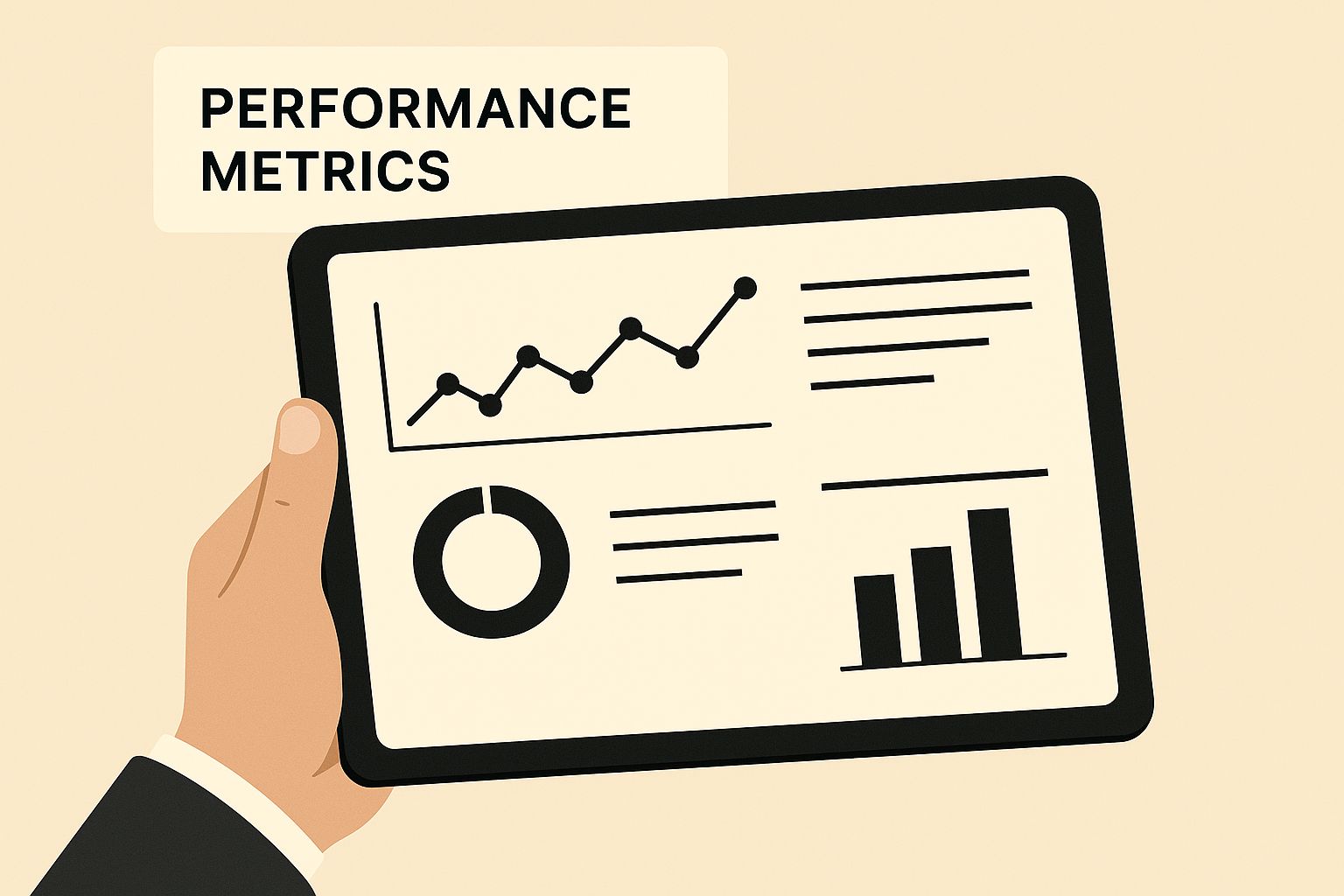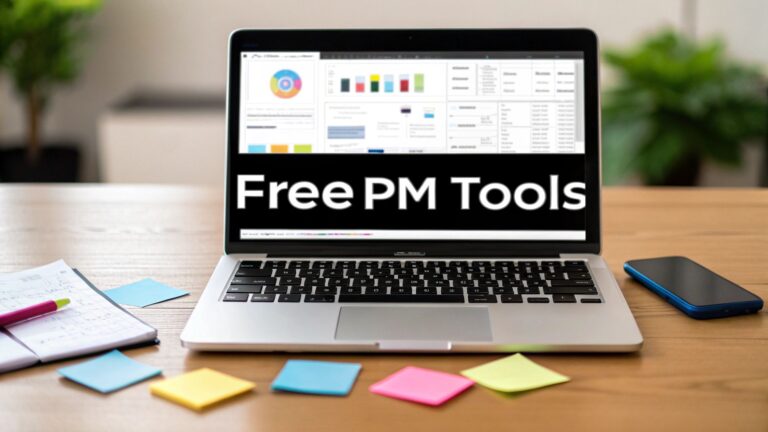What Is Organizational Effectiveness Explained
Organizational effectiveness is a fancy term for a simple, powerful idea: how good is a company at actually achieving what it sets out to do? It goes way beyond just being busy or hitting quarterly numbers. It’s about creating a business that's built to last—resilient, adaptable, and with all its parts moving in sync toward a common goal.
Defining Organizational Effectiveness

If you really want to get your head around what is organizational effectiveness, you have to look past simple metrics like revenue. While profit is obviously important, real effectiveness is about the entire system. It’s what separates a team that just checks off tasks from a team that achieves outcomes that fundamentally move the business forward.
Think of it like a championship-winning sports team. Their success isn't just about having one star player (strong sales). It’s about the seamless interplay of every element:
- A Clear Game Plan (Strategy): Everyone knows the plays, understands the opponent, and is aligned on the goal.
- Talented Players in the Right Positions (People): You have the right skills where you need them most, and everyone trusts their teammates to do their job.
- Flawless Execution (Processes): The passes are crisp, the defense is coordinated, and every move is practiced and efficient.
When all these pieces work together, the team doesn't just score points—it wins titles. That's the heart of organizational effectiveness.
This concept rests on three core pillars that work together to create a high-performing organization.
Here’s a quick breakdown of how these pillars connect to create a truly effective business.
The Three Pillars of Organizational Effectiveness
| Pillar | What It Means | Key Business Impact |
|---|---|---|
| Strategy | Having a clear, well-defined vision and a realistic plan to get there. It's the "why" and "how" behind everything the company does. | Ensures all efforts are focused on the right goals, preventing wasted resources and providing a clear direction for the entire team. |
| People | The talent, skills, culture, and leadership within the organization. It's about having the right people who are motivated and empowered to execute the strategy. | Drives innovation, productivity, and customer satisfaction. A strong culture attracts and retains top talent, creating a competitive advantage. |
| Processes | The workflows, systems, and structures that enable work to get done smoothly and consistently. It's the operational backbone of the company. | Creates reliability, reduces errors, and allows the business to scale. Efficient processes free up people to focus on high-value work. |
When these three pillars are strong and aligned, you get a business that is not just running, but thriving.
More Than Just Efficiency
It's really easy to mix up effectiveness with its close cousin, efficiency. But the difference is critical.
Efficiency is about doing things right. It's about optimizing a task to use the fewest resources—time, money, effort. For example, setting up a marketing automation workflow is an efficient move.
Effectiveness, however, is about doing the right things. It forces you to ask the bigger question: Is that super-efficient automation workflow actually helping us land the high-value clients we're targeting? An effective organization makes sure all its efficient processes are pointed directly at its most important strategic goals.
This is a subtle distinction, but it's where a lot of companies stumble. You can dive deeper into related concepts in our guide on what is Lean Methodology, which is all about creating more value with less waste.
The Real-World Impact
Chasing organizational effectiveness isn't just a feel-good corporate initiative; it's a hard-nosed business strategy. Companies that get this right are simply better prepared to handle market surprises, keep their teams on the same page, and consistently deliver results. The proof is in the numbers—well-aligned, effective companies deliver three times the shareholder value compared to their less cohesive competitors.
"Organizational effectiveness is the ultimate measure of a company’s health. It’s the ability to consistently deliver on promises to customers, employees, and shareholders by creating a system where the whole is truly greater than the sum of its parts."
Ultimately, this is about building a business that’s not just profitable this quarter but is strong, innovative, and set up for success for years to come. It’s about creating a well-oiled machine that can navigate challenges, jump on opportunities, and constantly get better at what it does.
Why Organizational Effectiveness Is Your Competitive Edge

In a market where everyone is chasing the same customers, just being busy is a surefire way to stand still. What really separates the companies that limp from one quarter to the next from those that build unstoppable momentum? It's organizational effectiveness.
Think of it as the engine that powers sustainable growth. This isn't about vague corporate ideals or mission statements that just hang on a wall; it's about real, tangible business results. When a company becomes truly effective, the positive effects ripple through every single department, impacting everything from daily operations to long-term market value. It becomes the difference between just surviving and genuinely thriving.
Driving Financial Performance and Market Share
Let’s be direct: a highly effective organization is a profitable one. When your strategy, people, and processes are all pulling in the same direction, you stop wasting resources on initiatives that don’t actually move the needle. This alignment naturally leads to smarter spending, more efficient operations, and healthier profit margins.
Take resource allocation, for example. We saw one startup shift its marketing budget from broad, expensive advertising to highly targeted social media campaigns after reviewing what was actually working. The result? A 25% increase in customer engagement while spending only 60% of the original budget. That’s not just saving money—it's making every dollar work harder to win more of the market.
Effective organizations also make better decisions, and they make them faster. They have clear data, their teams are on the same page, and they have the confidence to act on opportunities without getting stuck in bureaucratic mud. This agility is what allows them to outmaneuver slower competitors and react to market shifts before they turn into major problems.
Fostering a Culture of Innovation and Adaptability
The market never stops changing. Companies that can’t adapt get left behind—it's as simple as that. Organizational effectiveness builds resilience right into your company’s DNA. It creates an environment where innovation isn't just a buzzword assigned to a special projects team; it’s part of everyone's job.
How? By fostering psychological safety. When employees feel empowered to experiment, share new ideas, and even fail without fear of blame, that's when real breakthroughs happen.
Think about how the Post-It Note was invented at 3M. An experiment to create a super-strong adhesive actually "failed," producing a weak one instead. A less effective culture might have just tossed out the "failure." But 3M's environment allowed that mistake to be seen as an opportunity, ultimately leading to one of the most iconic office products in history.
This kind of culture, where you’re always improving and adapting, is what separates the good from the great. It allows companies to not only get through tough economic times but to come out the other side even stronger, with new products, better processes, and a more dedicated team.
Enhancing Customer and Employee Experiences
Your reputation in the market is a direct reflection of your internal health. An effective organization delivers a consistently superior experience to its customers precisely because its internal processes are smooth and its employees feel supported. When teams are aligned and information flows freely, customers get faster answers, better products, and service they can count on.
This internal harmony also has a massive impact on your own people. Disengaged employees are a huge drain on resources, costing U.S. companies an estimated $450 billion to $550 billion every year in lost productivity.
Organizational effectiveness is the perfect antidote to this problem. It works by:
- Clarifying Roles: Everyone understands exactly how their work contributes to the bigger picture, which gives their role a real sense of purpose.
- Breaking Down Silos: Collaboration becomes the default, not the exception. This cuts down on frustration and makes work more enjoyable and productive for everyone.
- Investing in Growth: Effective companies know their people are their most valuable asset. They provide clear paths for development, which is a huge factor in keeping top talent.
When your team is engaged and can see a real future with the company, they become its most passionate advocates. This creates a powerful cycle: a great employee experience leads directly to a great customer experience, which in turn fuels business growth and strengthens your brand.
The Four Core Drivers of High-Performing Organizations
Organizational effectiveness isn't something that just happens. It’s built, piece by piece, by focusing on four critical areas that all work together. Think of it like a high-performance engine with four cylinders—if one isn't firing right, the whole system sputters and loses power.
To really get a handle on what is organizational effectiveness in the real world, we have to look at these four components. When you get them all right, they create a powerful synergy that turns a group of people into a powerhouse capable of hitting ambitious targets. They also give you a clear roadmap for spotting weaknesses and building a tougher, more successful company.
1. Strategic Alignment
The first and most foundational driver is Strategic Alignment. This is the bedrock of everything else. It’s all about making sure every team, every department, and every person knows the company's big-picture mission and is actively pulling in the same direction to make it happen.
Without alignment, you get chaos. The marketing team launches a campaign for a product that engineering is about to kill. Sales chases a customer segment that doesn’t fit the long-term vision. It's like a rowing team where everyone is paddling at their own speed in different directions—lots of splashing, but you're not going anywhere.
Getting alignment right demands crystal-clear communication from the top about the company's vision, goals, and priorities. It’s about taking that high-level mission and breaking it down into real, tangible objectives that guide day-to-day work for everyone.
2. People and Culture
Next up is People and Culture, which is arguably the most important driver of all. At the end of the day, a company is just the people in it. A skilled, motivated, and engaged team is your ultimate competitive advantage because they're the ones who bring the strategy to life and come up with what's next.
This goes way beyond just hiring smart people. It’s about building a culture where everyone feels valued, psychologically safe, and trusted to do their best work. That means giving people room to grow, encouraging open and honest communication, and celebrating wins.
The connection between employee engagement and the bottom line is undeniable. Engaged teams are simply more productive and profitable. But shockingly, recent data shows that only about 21% of employees globally feel engaged at work. This huge engagement gap directly kneecaps a company's potential, as disengaged teams can be up to 23% less profitable and 18% less productive. You can dig into more details in the latest employee engagement statistics.
"Your culture is your brand. An organization that fosters a positive, growth-oriented culture doesn't just attract top talent; it creates an environment where that talent can thrive and drive the business forward."
A strong culture is like an invisible hand, guiding decisions and actions when no one's looking. It’s what keeps the team pushing through tough times and staying focused during rapid growth.
3. Processes and Structure
The third driver, Processes and Structure, forms the skeleton that holds everything together. This is about designing workflows that just work, creating clear lines of accountability, and putting systems in place that help people do great things instead of getting in their way. It’s the "how" behind getting work done efficiently and consistently.
Bad processes create bottlenecks, frustration, and a whole lot of wasted time. Imagine a software team with a brilliant idea stuck in a clunky, bureaucratic approval process for weeks. By the time they get the go-ahead, a competitor has already shipped a similar feature.
Effective organizations are always tweaking their processes to cut out the friction. They use automation for repetitive tasks, make sure everyone knows who’s responsible for what, and build strong communication lines between teams. A deep understanding of cross-functional collaboration is key to building these effective structures, ensuring departments work together as a single unit, not in separate silos.
This infographic gives a sense of how various performance metrics, which are governed by clear processes, can be tracked.

Being able to see data visualized on a tablet like this lets leaders quickly check performance and spot where processes are breaking down in real time.
4. Adaptability and Innovation
Finally, we have Adaptability and Innovation. In a world that’s always changing, the ability to pivot, learn, and innovate isn’t just nice to have—it’s essential for survival. An organization that’s killing it today could be irrelevant tomorrow if it can't keep up with new market demands, tech shifts, or competitive moves.
This driver is all about creating a forward-thinking mindset. It means encouraging experiments, learning from what doesn't work, and always looking for new ways to deliver value to customers. Adaptable companies aren't afraid to question how things have always been done or even disrupt their own successful products if it means staying ahead.
A perfect example is a B2B SaaS company that constantly uses market feedback to steer its two-week engineering sprints. This agile way of working lets them respond to customer needs in near real-time, fix bugs fast, and roll out valuable new features that keep them miles ahead of slower competitors.
These four drivers—Alignment, People, Processes, and Adaptability—aren't separate items on a checklist; they're deeply connected. A great culture is worthless without a clear strategy, and the world's best processes will fall flat without adaptable people to run them. True organizational effectiveness happens when all four are firing in perfect harmony.
How to Actually Measure Organizational Effectiveness
It's one thing to define organizational effectiveness, but another thing entirely to know if you've actually achieved it. As the old saying goes, you can’t improve what you don’t measure. But this isn't about just tracking a few KPIs on a spreadsheet; it's about moving from a vague feeling about your company's health to a clear, data-driven understanding.
Simply keeping an eye on revenue won’t tell you the whole story. It won’t tell you why you’re succeeding or where hidden problems might be quietly brewing. A holistic measurement strategy is what gives you the complete, honest picture.
Blending Quantitative and Qualitative Metrics
The most reliable way to gauge your organization's health is by combining two very different, but equally important, types of data. Think of it as the "what" and the "why."
Quantitative metrics are the "what"—the cold, hard numbers that are easy to track and compare. On the other hand, qualitative metrics are the "why"—the human context that gives those numbers real meaning.
An organization that only tracks numbers might see profits are up but completely miss that their top engineering team is on the verge of burnout. Conversely, a company running purely on good vibes and happy employee feedback might fail to notice a dangerous dip in market share until it's too late.
Here’s how you can combine both for a powerful, 360-degree view:
- Quantitative Metrics (The Numbers): These are objective, impartial, and directly measurable. Think financial performance indicators like profit margins and ROI, customer metrics like lifetime value (CLV) and acquisition cost (CAC), and HR data like employee turnover rates. They tell you if your outputs are hitting the mark.
- Qualitative Metrics (The Insights): This is the rich, contextual data gathered through surveys, conversations, and direct observation. It includes feedback from employee engagement surveys, 360-degree leadership reviews, and customer satisfaction comments. These metrics reveal the underlying health of your culture, systems, and people.
For a deeper dive into the quantitative side, especially when it comes to your team's output, check out our detailed guide on how to measure employee productivity.
Powerful Models for Measurement
You don't have to invent a measurement system from scratch. Fortunately, there are proven frameworks you can adapt to guide your efforts and connect your daily activities directly to your high-level strategic goals.
The goal isn’t to build a spreadsheet; it's to create a dashboard. You need a way to see how financial results, internal processes, customer loyalty, and team development all influence one another in real-time.
One of the most respected frameworks out there is the Balanced Scorecard. It pushes leaders to look at the business from four distinct perspectives—not just financial—to get a complete, balanced view of performance.
Another powerful approach is McKinsey's 7-S Model, which examines seven interconnected internal factors (like strategy, structure, and skills) to diagnose misalignments that could be silently hurting your effectiveness. And when it comes to evaluating specific areas like your company's vibe, various company culture assessment tools can offer incredibly targeted insights.
Comparing Models for Measuring Effectiveness
Choosing the right framework really depends on what your organization needs to focus on right now. Each model provides a different lens to look through, helping you zero in on what matters most.
| Model | Primary Focus | Best For | Example Metric |
|---|---|---|---|
| Balanced Scorecard | A holistic view connecting financial goals with operational, customer, and learning metrics. | Organizations that want to ensure their day-to-day actions directly support their long-term strategy. | Customer Net Promoter Score (NPS) linked to employee training completion rates. |
| McKinsey's 7-S | The alignment between seven core internal elements (Strategy, Structure, Systems, Skills, Staff, Style, Shared Values). | Companies undergoing change, such as a merger or a major strategic pivot, to identify points of friction. | A score rating the alignment between company strategy and the skills of current staff. |
| Goal-Attainment | The straightforward measurement of progress against predefined organizational goals. | Businesses with very clear, specific, and measurable objectives, such as hitting a certain market share. | Percentage of quarterly sales target achieved. |
Ultimately, by using a smart mix of quantitative data, qualitative feedback, and a structured model, you can move past guesswork. You’ll gain a clear, actionable understanding of what organizational effectiveness looks like inside your own walls, allowing you to fix what's broken and double down on what’s truly working.
Actionable Frameworks to Boost Your Effectiveness
Knowing what drives organizational effectiveness is one thing, but actually making it happen is a completely different ballgame. To get from theory to reality, you need reliable frameworks—proven roadmaps that guide you through diagnosing problems, planning your moves, and executing the plan. These aren't just academic exercises; they are battle-tested tools designed to bring focus and alignment to the messy, complex challenges of business.
Using a structured framework helps you stop guessing and start being systematic. It lets you pinpoint exactly where things are out of sync and create targeted plans to get back on track.
Let's walk through two of the most powerful and widely-used frameworks that can help you build a much more effective organization.
Diagnosing Misalignment with McKinsey's 7-S Model
One of the most durable tools for checking the health of an organization is the McKinsey 7-S Model. It’s a fantastic diagnostic tool that looks at a company as a web of seven interconnected parts. The core idea is simple but incredibly powerful: for an organization to really fire on all cylinders, all seven of these elements must be in alignment.
If one area is out of whack, you can bet it's causing problems elsewhere. The seven elements fall into two buckets:
Hard Elements (Easier to define and manage):
- Strategy: The plan you've created to gain and keep a competitive edge.
- Structure: How the company is organized—the org chart, who reports to whom.
- Systems: The day-to-day processes and procedures your teams use to get work done.
Soft Elements (Harder to nail down, often shaped by culture):
- Shared Values: The core beliefs and ethics that show up in the company culture. These are the "north star" of the organization.
- Style: The way leadership behaves and makes decisions.
- Staff: The employees themselves and their general capabilities.
- Skills: The specific competencies and skills your workforce possesses.
The real magic of the 7-S model is in how everything connects. You can have the most brilliant strategy on paper, but if your company structure creates silos and your staff doesn't have the skills to pull it off, you're going to fail. True effectiveness comes from harmony across all seven areas.
How It Works in the Real World
Imagine a B2B company just bought a smaller competitor. Their strategy is to integrate the new team and its product. Using the 7-S model, the leadership team can start asking the right alignment questions:
- Structure: How do we merge two different org charts without creating total chaos?
- Systems: Which CRM and project management tools will become our standard?
- Skills: Does the new team have the skills to work with our existing tech stack?
- Shared Values: How do we blend a scrappy startup culture with our more established corporate one?
By working through each of the seven elements, the company can build a thoughtful integration plan that reduces friction and gets everyone working as a single, effective team much faster.
Creating Radical Clarity with OKRs
While the 7-S model is perfect for diagnosis, the Objectives and Key Results (OKRs) framework is all about execution. OKRs are a goal-setting system that helps companies turn big-picture strategies into measurable, concrete results for every single team and individual.
The structure is beautifully simple:
- Objectives (O): These are your ambitious, qualitative goals. They answer the question, "What do we want to achieve?" They should be inspiring, not boring.
- Key Results (KR): These are the quantitative, measurable outcomes that prove you've reached your objective. You should aim for 2-5 Key Results for each Objective. They answer, "How will we know we got there?"
This framework creates intense clarity and alignment. Everyone, from the CEO to an intern, can see the company's top-level OKRs and understand exactly how their own work contributes to the bigger picture.
Putting OKRs into Practice
Let's say a SaaS firm's strategic goal is to accelerate product innovation. They might set an OKR like this:
- Objective: Become the industry leader in user-centric design by year-end.
- Key Result 1: Increase user satisfaction score from 7.5 to 9.0 by the end of Q4.
- Key Result 2: Reduce the average number of clicks to complete a key workflow from 8 to 4.
- Key Result 3: Ship 3 new features based directly on user feedback sessions.
There's no ambiguity here. The product team knows precisely what success looks like and can pour all their energy into hitting those specific, measurable targets. At the end of the day, making your organization more effective often requires a deep dive into comprehensive organizational transformation strategies.
Your Top Questions About Organizational Effectiveness, Answered
Once you start digging into organizational effectiveness, you’re bound to have some questions. It's one thing to understand the theory, but making it work in the real world is where the magic happens. Let's tackle some of the most common questions leaders ask when they shift their focus from just being busy to being truly effective.
Is This Just a Fancier Word for Efficiency?
This is easily the most common question, and the answer is a hard no. While they’re related, they are fundamentally different concepts.
-
Efficiency is about doing things right. It’s about speed, cost-cutting, and optimizing tasks. Think of it as making a process faster or cheaper, like automating your invoicing system.
-
Effectiveness is about doing the right things. It takes a step back and asks if that automated invoicing system is actually helping you achieve your bigger goal, like improving long-term client relationships.
Here’s a simple analogy: You can be incredibly efficient at climbing a ladder, taking every step perfectly without wasting a single movement. But if that ladder is leaning against the wrong building, all your effort is pointless. Efficiency is climbing the ladder fast; effectiveness is making sure you put it on the right wall in the first place.
How Do I Get Leadership to Buy Into This?
Getting the green light from the top is non-negotiable since any real change requires resources and a commitment to doing things differently. The trick is to speak their language: tangible business results.
Don't pitch abstract ideas like "improving our culture." Instead, build a clear, data-driven business case. Frame it as "a plan to reduce employee turnover by 15%" or "a strategy to increase our profit margin."
Connect every proposed change directly to the metrics your leadership team obsesses over—profit, customer acquisition cost, market share. Show them exactly how an investment in effectiveness will produce a return they can take to the bank.
A great way to start is with a small, manageable pilot project. Pick one department, get a quick win, and use that success story to build momentum. Nothing is more persuasive than proven results.
Does This Really Apply to Small Businesses and Startups?
Absolutely. The scale might be different, but the principles are universal. In fact, for smaller companies where every dollar and every decision counts, being effective isn't just a nice-to-have; it's a survival mechanism.
For a startup, being effective might look like:
- Keeping a small team perfectly aligned on the product roadmap to avoid wasted effort.
- Building simple, clean processes that won’t break as you start to grow.
- Creating a strong culture from day one that attracts and keeps the right people.
You don't need a massive, complex framework like the Balanced Scorecard to be effective when you're small. What you do need is a relentless focus on making sure your strategy, your people, and your processes are all pointing in the same direction—toward your most important goals. An effective organization, no matter its size, is one that consistently achieves what it sets out to do.
Ready to stop wasting time on manual processes and build a truly effective organization? MakeAutomation specializes in implementing the automation and AI systems that give B2B and SaaS companies a competitive edge. We build the streamlined workflows that let your team focus on high-impact work. Discover how we can help you scale.







